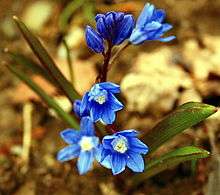Chionodoxa sardensis
| Chionodoxa sardensis | |
|---|---|
 | |
| Scientific classification | |
| Kingdom: | Plantae |
| Clade: | Angiosperms |
| Clade: | Monocots |
| Order: | Asparagales |
| Family: | Asparagaceae |
| Subfamily: | Scilloideae |
| Genus: | Chionodoxa |
| Species: | C. sardensis |
| Binomial name | |
| Chionodoxa sardensis Whittall ex Barr & Sugden | |
Chionodoxa sardensis, the lesser glory-of-the-snow,[1] is a bulbous perennial from west Turkey flowering in early spring. After flowering, it goes into dormancy until the next spring.
Like all members of the genus Chionodoxa, the bases of the stamens are flattened and closely clustered in the middle of the flower. In the related genus Scilla, the stamens are not flattened or clustered together.[2] The differences are not considered by some botanists as sufficient to create a separate genus, so they include this species in Scilla.[3]
C. sardensis resembles C. forbesii, but has a less distinct white 'eye'.[3] Each bulb produces two-three leaves, up to 13.6 cm long and 1.5 cm wide, and at most one flowering stem, up to 14 cm long. The flowers are produced in a loose pyramidal to one-sided raceme, with up to 22 flowers per stem. Each flower is up to 2.5 cm across, with individual tepals 1.5 cm long. The tepals are violet-blue, somewhat paler at the base, producing a paler 'eye' at the centre of the flower.[4] The stamen bases are white.[5]
Notes and references
- ↑ "BSBI List 2007". Botanical Society of Britain and Ireland. Archived from the original (xls) on 2015-02-25. Retrieved 2014-10-17.
- ↑ Mathew 1987, p. 25
- 1 2 Dashwood & Mathew 2005, p. 5
- ↑ Dashwood & Mathew 2005, p. 7 (However, some bulbs grown under this name from cultivated stock appear to have a white eye similar to C. siehei.)
- ↑ According to Brian Mathew (pers. comm.), Dashwood & Mathew (2005) is in error in saying that they are violet-blue.
Bibliography
- Dashwood, Melanie & Mathew, Brian (2005), Hyacinthaceae – little blue bulbs (RHS Plant Trials and Awards, Bulletin Number 11), Royal Horticultural Society, archived from the original on 28 August 2015, retrieved 28 August 2015* Mathew, Brian (1987), The Smaller Bulbs, London: B T Batsford, ISBN 978-0-7134-4922-8
- Mathew, Brian (2005), "Hardy Hyacinthaceae, Part 2: Scilla, Chionodoxa, xChionoscilla", The Plantsman (New Series), 4 (2): 110–21